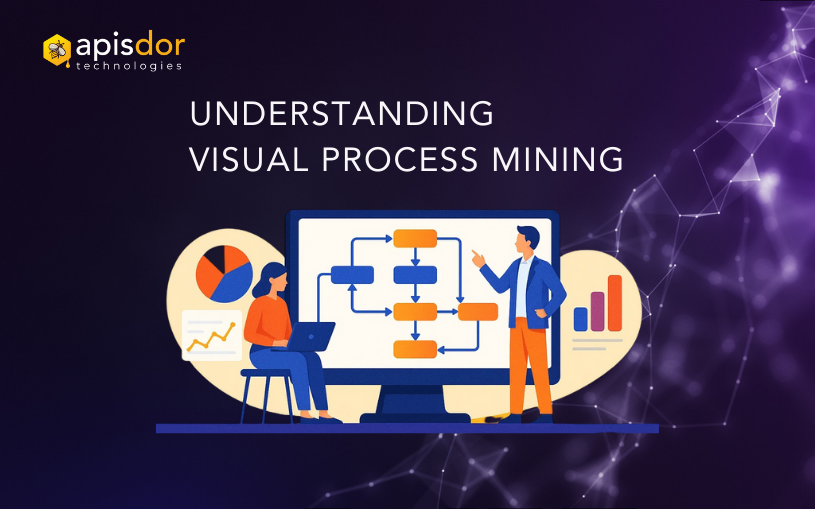Visual Process Mining Stimulates Business Automation with Low-Code Tools

The landscape of business operations is changing quickly, driven by advancements in technology and growing demands for efficiency. One of the main trends in this transformation is visual process mining. This innovative method of data analysis reveals hidden insights and speeds up business automation by using low-code tools. Embracing visual process mining enables organizations to streamline workflows, improve decision-making, and achieve significant cost savings.
Understanding the importance of visual process mining is crucial in today’s competitive landscape. We will discuss its key components, methodologies, and practical applications in business automation. Additionally, we’ll examine how integrating low-code solutions empowers non-technical users to take part in improving processes. With this knowledge, businesses can better leverage technology.
Understanding Visual Process Mining
Visual process mining is a method for analyzing business processes using data collected from various IT systems. Algorithms convert complex data logs into easy-to-understand visual formats, enabling stakeholders to identify inefficiencies and bottlenecks.
The importance of visual process mining is evident: it provides a visual context to the data, allowing teams to critically examine process flows. For example, studies show that companies that use process mining can see a 20% increase in efficiency. According to a report by the International Journal of Information Systems, organizations that adopted process mining techniques reported substantial improvements in operational transparency.
The Role of Data in Process Mining
The core of visual process mining lies in data. Organizations must gather high-quality and relevant data from their processes, as this data forms the basis for analysis, driving insights, and supporting better decision-making.
Using low-code tools for data management can simplify this process. These tools let users easily connect various data sources, manipulate data formats, and perform analyses without needing extensive programming knowledge.
Integrating Low-Code Tools in Process Mining
Low-code tools have transformed how businesses approach process automation and analysis, reducing their reliance on IT specialists. This empowerment enables business users to create solutions tailored to their needs.
By incorporating low-code platforms with visual process mining, organizations can automate repetitive tasks and visualize workflows without complex technical setups. A leading low-code platform revealed that organizations using their software achieved development times that were up to 50% faster.
This integration allows business analysts and managers to design and track complex processes visually, enhancing efficiency and productivity.
Key Benefits of Visual Process Mining with Low-Code Solutions
The combination of visual process mining and low-code tools provides several advantages:
- Improved Agility: Organizations can quickly adapt and modify processes based on real-time data insights.
- Enhanced Collaboration: Non-technical stakeholders can easily visualize and join process discussions, fostering teamwork across departments.
- Cost-Effective Solutions: Less dependence on technical teams can lead to savings in time and resources.
For example, a manufacturing company that adopted this strategy reported a 30% reduction in lead times thanks to optimized processes.
Real-World Applications in Various Industries
Visual process mining is not just a theoretical concept; it has practical uses in multiple sectors:
- Healthcare: Improving patient journeys and optimizing resource use can significantly enhance care.
- Finance: Removing process bottlenecks in mortgage approvals can lead to quicker service delivery.
- Retail: Analyzing customer journey data can refine sales processes.
For instance, a healthcare provider successfully employed visual process mining to reduce patient wait times by identifying improvement areas in their appointment scheduling systems.
Challenges and Considerations
Despite the significant advantages, businesses should be aware of the challenges when implementing visual process mining:
- Data Quality: Maintaining data integrity is vital for accurate insights.
- User Adoption: Training staff to use low-code tools effectively can be a challenge.
Addressing these challenges through proper training and ongoing monitoring can yield better results.
Future of Visual Process Mining
The future of visual process mining looks promising as technology evolves. Increased integration with AI and machine learning will enhance predictive analytics capabilities.
This change will empower businesses to make data-driven decisions more swiftly and accurately. A Gartner survey indicated that by 2026, 70% of business processes will be automated, highlighting the importance of tools like visual process mining and low-code solutions.
Conclusion
Visual process mining, combined with low-code tools, offers a significant advancement in business automation. As organizations value data-driven insights, this approach not only boosts operational efficiency but also makes process improvement technologies accessible to everyone. Businesses embracing these innovations will navigate today’s market complexities more effectively.
The essential takeaway is clear: investing in visual process mining and low-code solutions can lead to real results in reducing costs, enhancing workflows, and improving collaboration. Organizations must adapt now to unlock their full potential.
FAQs
Q1: What is visual process mining?
A: Visual process mining is a data analysis technique that converts business process data into visual formats to spot inefficiencies and enhance workflows.
Q2: How do low-code tools assist in process mining?
A: Low-code tools simplify data management for business users, allowing them to automate processes and visualize workflows without deep technical expertise.
Q3: Why is data quality important in visual process mining?
A: High-quality data ensures accurate insights and effective decision-making, making it vital for successful process analysis.
Q4: What industries can benefit from visual process mining?
A: Numerous industries, including healthcare, finance, and retail, can optimize processes and boost performance through visual process mining.
Q5: What are the key benefits of combining visual process mining with low-code tools?
A: Key benefits include increased agility, improved collaboration, and cost-effectiveness due to less dependence on IT for process solutions.
